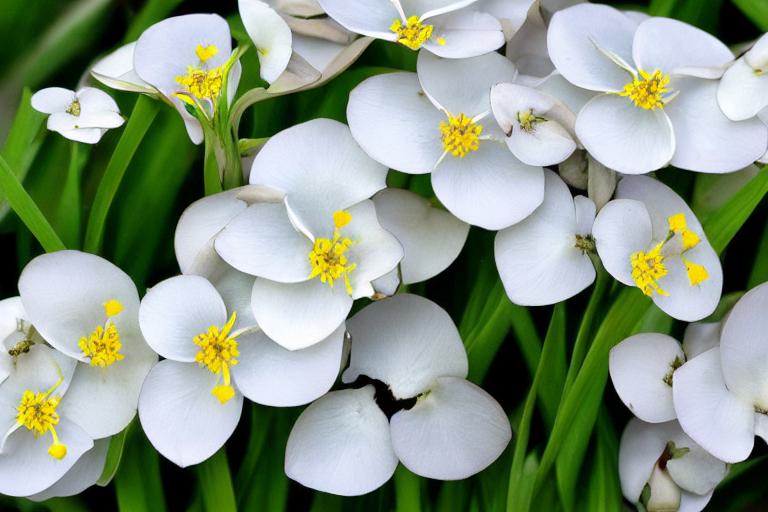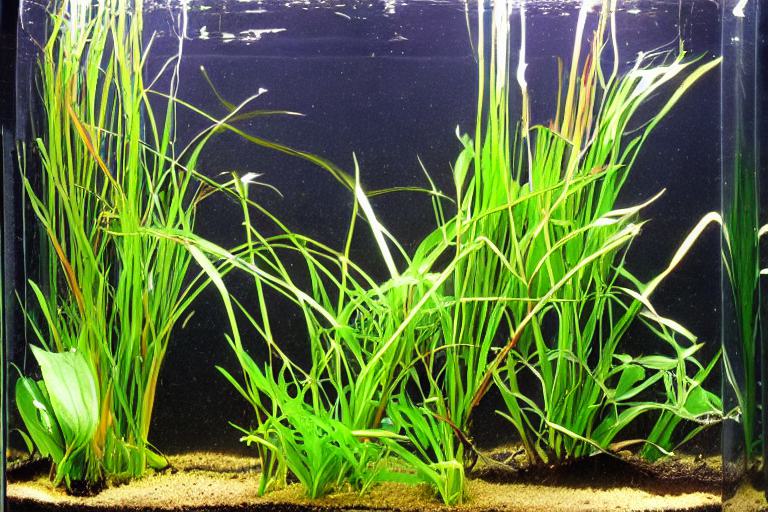If you’re looking to add a Dwarf Sagittaria to your aquarium, you’ve come to the right place. In this guide, we’ll go over everything you need to know to get started, including what to look for when choosing a plant, how to plant it, and what kind of care it needs. By the end, you’ll be an expert on Dwarf Sagittarias and be able to get your new plant off to a great start.
What is the dwarf Sagittaria?
Dwarf Sagittaria is a plant that is native to North and South America. It is a member of the Alismataceae family and is also known by the names Arrowhead, Wapato, or Duck Potato. The leaves of the plant are arrowhead-shaped, and the flowers are white or yellow. The plant reproduces by producing small, brown, oval-shaped fruits. The plant grows in wetland areas and is often found in marshes, ponds, and ditches.
The plant is fast-growing and can quickly spread through its rhizome system. The plant does best in full sun to partial shade and in soil that is rich in organic matter. It is easy to care for and can tolerate a wide range of water conditions. Dwarf Sagittaria is a popular plant for aquariums and water gardens. Dwarf Sagittaria can be propagated by division or by seed.

Natural habitat
A natural habitat for dwarf sagittaria is a slow-moving water body with soft, muddy substrate and plenty of aquatic vegetation. The ideal temperature range for this plant is between 68 and 86 degrees Fahrenheit.
This plant is native to North America, where it is commonly found in marshes, swamps, and other wetland habitats. Dwarf sagittaria is a popular choice for aquarium and pond plantings because it is relatively easy to care for and can tolerate a wide range of water conditions.
However, in aquarium and pond settings, this plant is often trimmed to maintain a smaller size. Dwarf sagittaria can be propagated by division or by seed. This plant blooms from late spring to early summer, producing small, white flowers. In the wild, dwarf sagittaria typically grows to a height of about 12 inches.
Tank Size, Water Parameters, and Lighting Requirements
A small tank size of 10-20 gallons is sufficient for a single plant. However, if you plan on keeping multiple plants, you will need a larger tank size. When it comes to choosing a tank size for your dwarf sagittaria, it is important to consider the water parameters and lighting requirements of the plant.
It is important to keep the water clean and free of debris. The water parameters for dwarf sagittaria are relatively easy to maintain. The plant prefers a pH level between 6.5 and 7.5 and a water temperature of 75-85 degrees Fahrenheit.
The plant can grow in both low and high light conditions. The lighting requirements for dwarf sagittaria are not very demanding. However, it is important to provide a source of direct sunlight for the plant to thrive.
Tank Size
When it comes to choosing a tank size for your dwarf sagittaria, there are a few things to keep in mind. A 20 gallon tank would be a better choice if you have the space. Second, dwarf sagittaria are fast growers, so they’ll need plenty of room to spread out. Finally, keep in mind that dwarf sagittaria are best kept in groups, so you’ll need to factor in the space needed for multiple plants. A 10 gallon tank should be more than sufficient. First, dwarf sagittaria are relatively small plants, so they won’t need a lot of space.
If you’re limited on space, a 10 gallon tank should be fine, but try to go for a larger size if you can. In general, a larger tank is always better when it comes to plants. They’ll have more room to grow and spread out, and you’ll be able to maintain a healthier environment.

Water parameters
The plant can tolerate a wide range of temperatures, but prefers water that is on the cooler side, around 72-82 degrees Fahrenheit. Water parameters are extremely important when keeping dwarf sagittaria. In the home aquarium, dwarf sagittaria will do best in slightly acidic to neutral water with a pH of 6.0-7.5. The plant is native to marshes and stagnant waters, so it is used to living in nutrient-rich environments.
However, to ensure optimal growth and health, it is important to maintain stable water parameters. Water changes and regular testing will help to ensure that your plant stays healthy and happy. Dwarf sagittaria is a very versatile plant and can adapt to a wide range of water conditions.
Temperature
If the temperature rises above 82 degrees, the plant will start to produce fewer leaves. They will do best in an aquarium that is kept between 75 and 82 degrees Fahrenheit. Sagittaria are tropical plants, so they prefer warm temperatures. If the temperature drops below 75 degrees, the plant will start to lose its leaves.
pH
pH is a measure of the acidity or alkalinity of a solution. A solution with a pH less than 7 is considered acidic, while a solution with a pH greater than 7 is considered basic or alkaline. The pH scale ranges from 0 to 14, with 7 being neutral.
Dwarf sagittaria (Sagittaria subulata) is a common aquatic plant that is often used in aquariums and ponds. The plant is native to North and South America, but it has been introduced to other parts of the world.
The plant can tolerate a wide range of pH levels, but it may not thrive in very acidic or very alkaline conditions. Dwarf sagittaria prefers neutral to slightly alkaline conditions, with a pH of 6.5-7.5 being ideal. If the pH of your aquarium or pond is outside of the ideal range, you can try to adjust it gradually to the desired level.
GH
This hardy plant is relatively easy to care for and can tolerate a wide range of water conditions. If you’re looking for a low-maintenance aquatic plant for your aquarium, dwarf sagittaria (GH) is a great option.
Here’s a quick guide to caring for dwarf sagittaria:
Lighting: Dwarf sagittaria prefers bright, direct light. If your aquarium doesn’t get enough natural light, you may need to supplement with artificial lighting.
Water Conditions: This plant is tolerant of a wide range of water conditions, from fresh to brackish. However, it prefers slightly alkaline water with a pH of 7.5-8.5.
Fertilizer: Dwarf sagittaria is a heavy feeder and will benefit from regular fertilization. Use a liquid fertilizer or slow-release pellets designed for aquatic plants.
Replant the sections in the substrate and provide bright, direct light. Each section should have at least one leaf. To do this, carefully remove the plant from the aquarium and gently pull it apart. Propagation: Dwarf sagittaria can be propagated by dividing the rhizomes.
KH
KH is a Dwarf Sagittaria that is native to the United States. It is a hardy plant that can tolerate a wide range of conditions, making it a good choice for beginner aquarists. KH is a low-maintenance plant that does not require much care, and it can thrive in both low and high light conditions.
Lighting
They can do well in a variety of lighting conditions, from low to high. If you have them in high light, they will grow faster and will flower more. When it comes to lighting, Dwarf Sagittarias are not too picky. The only thing to keep in mind is that if you have them in low light, they will grow slower and may not flower as much.
They can do well in a variety of lighting conditions, from low to high. If you have them in high light, they will grow faster and will flower more. When it comes to lighting, Dwarf Sagittarias are not too picky. The only thing to keep in mind is that if you have them in low light, they will grow slower and may not flower as much.
It really depends on your individual plant and what you want it to do. If you want it to grow slowly and not flower as much, then low light is the way to go. So, what’s the best lighting for Dwarf Sagittarias? If you want it to grow quickly and flower a lot, then high light is the way to go.
CO2 and Fertilization for the dwarf Sagittaria
Dwarf Sagittaria is a great plant for beginners as it is very tolerant to different water conditions and does not require special care. This plant is native to South America and can be found in slow-moving waters. This plant can grow in both fresh and salt water. Dwarf Sagittaria is a popular plant for aquariums and aquascaping due to its low maintenance and easy care.
One of the great things about this plant is that it can help to remove excess CO2 from the water. This is due to the plant’s ability to absorb CO2 and use it for photosynthesis. This plant is very tolerant to different water conditions and does not require special care. Dwarf Sagittaria is a great plant for beginners due to its easy care.
One of the benefits of keeping Dwarf Sagittaria in your aquarium is that it can help to improve the water quality. This plant is very efficient at removing excess nutrients and toxins from the water. Dwarf Sagittaria is also a great plant for providing oxygen to the water. This helps to create a healthier environment for your fish and other aquatic creatures.
Trimming and propagation
If you want to keep your dwarf sagittaria looking its best, you’ll need to trim it regularly. Trimming not only keeps the plant looking neat and tidy, but it also helps to encourage new growth.
To trim your dwarf sagittaria, simply cut back any dead or dying leaves with a sharp pair of scissors. You can also trim back any stems that have become too long or leggy.
After a few weeks, you should see roots start to form. This is easy to do by simply placing the trimmings in a glass of water. Once the roots are a few inches long, you can then pot them up into their own pots. Once you’ve trimmed your plant, it’s a good idea to propagate the trimmings.
Frequently Asked Questions
1. What is Dwarf Sagittaria?
Dwarf Sagittaria is a small, aquatic plant that is native to North America. It is often found in ponds and streams.
2. What does Dwarf Sagittaria look like?
Dwarf Sagittaria has long, narrow leaves that are typically green in color. The plant can grow to be about 12 inches tall.
3. How do I care for Dwarf Sagittaria?
Dwarf Sagittaria is relatively easy to care for. It prefers to grow in full sun to partial shade and needs to be in an area that has moist soil.
4. What are the benefits of growing Dwarf Sagittaria?
Dwarf Sagittaria is a great plant for beginners because it is easy to care for. It is also a good choice for people who want to add some greenery to their pond or stream.
5. Are there any drawbacks to growing Dwarf Sagittaria?
One potential drawback of growing Dwarf Sagittaria is that it can spread quickly and become invasive in some areas.
Final thoughts
If you’re looking for an easy-to-care-for plant that will add some interest to your aquarium, look no further than dwarf sagittaria. This plant is perfect for beginners, as it is very tolerant of a wide range of conditions. With a little bit of research, you can easily find the perfect spot for your dwarf sagittaria to thrive.
